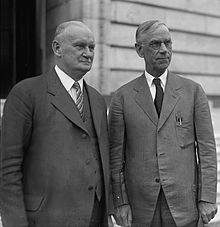Smoot-Hawley Tariff Act

The Smoot-Hawley Tariff Act (English. Smoot-Hawley Tariff Act ) was a federal law of the United States enacted on June 17, 1930 , with which the US tariffs on over 20,000 products were raised to record levels. The protectionist law aimed to protect the United States economy from foreign competition . The law was criticized from many sides at the time and is held responsible for the worsening of the global economic crisis .
Emergence
The Smoot-Hawley Tariff Act is named after its initiators, Senator Reed Smoot from Utah and Willis C. Hawley , a member of the House of Representatives from Oregon . It was adopted by the House of Representatives on May 28, 1929. 264 members voted for the law and 147 against. Of the supporters, 244 were Republicans and 20 were Democrats . It was passed in the Senate by 44 votes to 42, with 39 Republicans and five Democrats voting for the bill.
It was enacted into law on June 17, 1930 by President Herbert Hoover .
criticism
Henry Ford and Thomas W. Lamont called the law "economic stupidity" and "stupid". In May 1930, 1,028 economists signed a petition against the Smoot-Hawley Tariff Act organized by Paul Douglas , Irving Fisher , James TFG Wood, Frank Graham, Ernest Patterson, Henry Seager , Frank Taussig, and Clair Wilcox . In his 1932 presidential campaign, Democrat and later President Franklin D. Roosevelt spoke out against the law. Over thirty foreign governments formally protested.
Effects
The law played a large part in the decline in United States' foreign trade . US imports decreased 66% from $ 4.4 billion to $ 1.5 billion between 1929 and 1933. Exports fell 61% from $ 5.4 billion to $ 2.1 billion. Imports from Europe fell from $ 1.334 billion in 1929 to $ 390 million in 1932, and exports to Europe from $ 2.341 billion to $ 784 million. The law exacerbated protectionist tendencies in international trade. Numerous states followed the American example of economic nationalism and raised their tariffs or sought self-sufficiency . Trade agreements were increasingly concluded bilaterally, and instruments of multilateralism such as the most-favored nation clause were no longer used. As a result, world trade shrank, which significantly exacerbated the global economic crisis. By 1933, world trade had declined by about 60%.
Both Reed Smoot and Willis C. Hawley missed re-election to Congress in 1932 .
Web links
- Entry in the EH.net Encyclopedia (English)
Individual evidence
- ↑ Bonus, Holger: securities, money and gold: about the unreal in the economy . Verlag Styria, Graz 1990, ISBN 3-222-11944-9 , p. 70 (oclc = 23767986 [accessed April 14, 2020]).
- ↑ Detlef Junker : The indivisible world market. Economic Interest in US Foreign Policy 1933–1941 . Ernst Klett, Stuttgart 1975, p. 280; Florian Pressler: The first world economic crisis. A Little History of the Great Depression. Munich 2013, ISBN 978-3-406-64535-8 , pp. 75 f .; Charles P. Kindleberger : The Great Depression 1929-1939. New edition, FinanzBook, Munich 2013, p. 169 ff.
- ^ Robert Carbaugh: International Economics. 16th edition, Cengage Learning, Boston 2016, pp. 187 f.